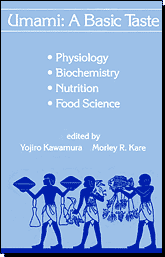
edited by Y. Kawamura and M.R. Kare, Marcel Dekker, New York, 1987
| Part One General Concepts | ||
| 1 | Recent Progress in the Taste Receptor Mechanism | Kenzo kurihara |
| 2 | Fundamental Properties of Umami in Human Taste Sensation | Shizuko Yamaguchi |
| 3 | The Umami Taste Concept: Implications for the Dogma of Four Basic Tastes | Michael O’Mahony and Rie Ishii |
| Part Two Developmental Aspects | ||
| 4 | What the Neonate Can Tell Us About Umami | Jacob E. Steiner |
| 5 | Dietary Status of Human Infants and Their Sensory Responses to Amino Acid Flavor | Gary K. Beauchamp, Martha Vazquez de Vaquera, and Paul B. Pearson |
| 6 | Flavor Preference for Monosodium Glutamate and Casein Hydrolysate in Young and Elderly Persons | Claire Murphy |
| Part Three Receptor Mechanisms | ||
| 7 | Allosteric Regulation of Glutamate Taste Receptor Function | Robert H. Cagan |
| 8 | Structure, Chirality, and Solution Properties of Glutamates in Relation to Taste | Gordon G. Birch |
| 9 | Multiplicity of Taste Receptor Mechanisms for Amino Acids in the Carp, Cyprinus caroio L. | Takayuki Marui, Shuitsu Harada, and Yasuo Kasahara |
| 10 | Mammalian Neural Taste Responses to Amino Acids and Nucleotides | James C. Boudreau |
| 11 | Synergistic Effects of 5′-Nucleotides on Rat Taste Responses to Various Amino Acids | Kiyonori Yoshii |
| Part Four Psychometric Analysis | ||
| 12 | Role of Extractive Components Of Boiled Crab in Producing the Characteristic Flavor | Shoji Konosu, Tetsuhito Hayashi, and Katsumi Yamaguchi |
| 13 | 0rganoleptic Properties of Umami Substances | Joseph A. Maga |
| 14 | Psychophysical and Neurophysiological Taste Responses to Glutamate and Purinergic Compounds | Susan S. Schiffman and James M. Gill |
| 15 | Taste Components and Conditioning of Beef, Pork, and Chicken | Hiromichi Kato and Toshihide Nishimura |
| 16 | Use of Sensory Evaluation and Food Habits Data in Product Development | Herbert L. Meiselman |
| 17 | Human Judgments of MSG Tastes: Quality and Reaction Times | Bruce P. Halpern |
| 18 | Isolation of Peptides as a Group by Ligand Exchange Chromatography | Bernard Monjon and Jürg Solms |
| Part Five Physiology and Behavior | ||
| 19 | Qualitative Discrimination Among “Umami” and the Four Basic Taste Substances in Mice | Yuzo Ninomiya and Masaya Funakoshi |
| 20 | MSG as One of the Sensitivities Within a Continuous Taste Space: Electrophysiological and Psychophysical Studies | Annick Faurion |
| 21 | The Effect of Physiological Condition on Taste in Rats and Primates | Thomas R. Scott and barbara K. Giza |
| Part Six Brain Mechanisms | ||
| 22 | Studies on Responses of Cortical Taste Neurons to Umami Substances | Takashi Yamamoto, Katsumi Asai, and Yojiro Kawamura |
| 23 | Behavioral Analysis of the Oral Stimulating Effects of Amino Acids and Glutamate Compounds on the Rat | Harvey J. Grill and Francis W. Flynn |
| 24 | Modulation of Prefrontal and Hypothalamic Activity by Chemical Senses in the Chronic Monkey | Yutaka Oomura |
| Part Seven Nutrition and Behavior | ||
| 25 | Biochemical Mechanism of Umami Taste Perception and Effect of Dietary Protein on the Taste Preference for Amino acids and Sodium Chloride in Rats | Kunio Torii, Toru Mimura, and Yasumi Yugari |
| 26 | The effect of Amino Acids and Protein on Dietary Choice | Philip M. B. Leung and Quinton R. Rogers |
| 27 | Effects of Dietary Protein Level and Umami on Taste Preference for Sodium Chloride | Shuichi Kimura, Yoshiko Yokomukai, and Michio Komai |
| Part Eight Overview | ||
| 28 | Recent Developments in Umami Research | Yojiro Kawamura and Bruce P. Halpern |